

Lyon
Liyon (Franco-Provençal)
| |
|---|---|
Prefecture and commune
| |
|
Place des Terreaux with the 'Fontaine Bartholdi Confluence District | |
| Motto(s):
Avant, avant, Lion le melhor
(old Franco-Provençal for "Forward, forward, Lyon the best")[a] Virtute duce, comite fortuna ("With virtue as guide and fortune as companion")[b] | |
Location of Lyon | |
|
Show map of France Show map of Auvergne-Rhône-Alpes | |
| Coordinates: 45°46′N 4°50′E / 45.76°N 4.84°E / 45.76; 4.84 | |
| Country | France |
| Region | Auvergne-Rhône-Alpes |
| Metropolis | Lyon Metropolis |
| Arrondissement | Lyon |
| Subdivisions | 9arrondissements |
| Government | |
| • Mayor (2020–2026) | Grégory Doucet[2] (EELV) |
| Area
1
| 47.87 km2 (18.48 sq mi) |
| • Urban
(2020[3])
| 1,141.4 km2 (440.7 sq mi) |
| • Metro
(2020[4])
| 4,605.8 km2 (1,778.3 sq mi) |
| Population
(2021)[5]
| 522,250 |
| • Rank | 3rd in France |
| • Density | 11,000/km2 (28,000/sq mi) |
| • Urban
(Jan. 2020[6])
| 1,693,159 |
| • Urban density | 1,500/km2 (3,800/sq mi) |
| • Metro
(Jan. 2020[7])
| 2,293,180 |
| • Metro density | 500/km2 (1,300/sq mi) |
| Time zone | UTC+01:00 (CET) |
| • Summer (DST) | UTC+02:00 (CEST) |
| INSEE/Postal code |
69123 /69001-69009
|
| Elevation | 162–349 m (531–1,145 ft) |
| Website | www |
| 1 French Land Register data, which excludes lakes, ponds, glaciers > 1 km2 (0.386 sq mi or 247 acres) and river estuaries. | |
Lyon[c] (Franco-Provençal: Liyon), formerly spelled in English as Lyons,[d] is the third-largest city of France.[e] It is located at the confluence of the rivers Rhône and Saône, to the northwest of the French Alps, 391 km (243 mi) southeast of Paris, 278 km (173 mi) north of Marseille, 113 km (70 mi) southwest of Geneva, 58 km (36 mi) northeast of Saint-Étienne.
The City of Lyon had a population of 522,000 in 2023 within its small municipal territory of 48 km2 (19 sq mi),[14] but together with its suburbs and exurbs the Lyon metropolitan area had a population of 2,293,180 that same year,[7] the second most populated in France. Lyon and 58 suburban municipalities have formed since 2015 the Metropolis of Lyon, a directly elected metropolitan authority now in charge of most urban issues, with a population of 1,416,545 in 2020.[15] Lyon is the prefecture of the Auvergne-Rhône-Alpes region and seat of the Departmental CouncilofRhône (whose jurisdiction, however, no longer extends over the Metropolis of Lyon since 2015).
The capital of the Gauls during the Roman Empire, Lyon is the seat of an archbishopric whose holder bears the title of Primate of the Gauls. Lyon became a major economic hub during the Renaissance. The city is recognised for its cuisine and gastronomy, as well as historical and architectural landmarks; as such, the districts of Old Lyon, the Fourvière hill, the Presqu'île and the slopes of the Croix-Rousse are inscribed on the UNESCO World Heritage List. Lyon was historically an important area for the production and weaving of silk. Lyon played a significant role in the history of cinema since Auguste and Louis Lumière invented the cinematograph there. The city is also known for its light festival, the Fête des Lumières, which begins every 8 December and lasts for four days, earning Lyon the title of "Capital of Lights".
Economically, Lyon is a major centre for banking, chemical, pharmaceutical and biotech industries. The city contains a significant software industry with a particular focus on video games; in recent years it has fostered a growing local start-up sector.[16] The home of renowned universities and higher education schools, Lyon is the second-largest student city in France, with a university population of nearly 200,000 students within the Metropolis of Lyon.[17] Lyon hosts the international headquarters of Interpol, the International Agency for Research on Cancer, as well as Euronews. According to the Globalization and World Rankings Research Institute, Lyon is considered a Beta city, as of 2018[update].[18] It ranked second in France and 40th globally in Mercer's 2019 liveability rankings.[19]
The name of the city has taken the forms Lugdon, Luon, and since the 13th century, Lyon. The Gallic LugdunorLugdunon that was Latinized in Roman as Lugdunum is composed of two words. The first may be the name of the Celtic god Lug (in charge of order and law), or the derived word lugon, meaning "crow" (the crow being the messenger of Lug), but might also be another word lug, meaning "light". The second is dunos ('fortress', 'hill'). The name thus may designate the hill of Fourvière, on which the ancient city of Lyon is founded, but could mean "hill of the god Lug", "hill of the crows" or "shining hill". [20] [21] Alternatively Julius Pokorny associates the first part of the word with the Indo-European radical *lūg ('dark, black, swamp'), the basis of the toponyms Ludza in Latvia, Lusatia in Germany (from Sorbian Łužica), and several places in the Czech Republic named Lužice;[22] it could then also be compared to Luze in Franche-Comté and various hydronyms such as Louge.
Further down, in the current Saint-Vincent district, was the Gallic village of Condate, probably a simple hamlet of sailors or fishermen living on the banks of the Saône. Condate is a Gallic word meaning "confluence", from which the Confluence district gets its name.
InRoman times the city was called Caput Galliæ, meaning "capital of the Gauls". As an homage to this title, the Archbishop of Lyon is still called the Primate of Gaul.
During the revolutionary period, Lyon was renamed Commune-Affranchie ("Emancipated Commune") on 12 October 1793 by a decree of the Convention Nationale. It resumed its name in 1794, after the end of the Terror.
Lyon is called LiyoninFranco-Provençal.[23]
Roman Empire (Gallia Lugdunensis), 43 BC-286
Western Roman Empire (Gallia Lugdunensis), 286-411
Kingdom of the Burgundians, 411–534
Francia, 534–843
Middle Francia, 843–855
Lotharingia, 855–879
Lower Burgundy, 879-933
Kingdom of Arles, 933–1312
Kingdom of France (Lyonnais), 1312–1792
French First Republic, 1792–1793
Counter-revolutionary, 1793
French First Republic, 1793–1804
First French Empire, 1804–1814
Kingdom of France, 1814–1815
First French Empire, 1815
Kingdom of France, 1815–1830
Kingdom of France, 1830–1848
French Second Republic, 1848–1852
Second French Empire, 1852–1870
French Third Republic, 1870–1940
Vichy France, 1940–1944
French Fourth Republic, 1944–1958
France, 1958–present
According to the historian Dio Cassius, in 43 BC, the Roman Senate ordered the creation of a settlement for Roman refugees of war with the Allobroges. These refugees had been expelled from Vienne and were now encamped at the confluence of the Saône and Rhône rivers. The foundation was built on Fourvière hill and officially called Colonia Copia Felix Munatia, a name invoking prosperity and the blessing of the gods. The city became increasingly referred to as Lugdunum (and occasionally Lugudunum[24]).[25] The earliest translation of this Gaulish place-name as "Desired Mountain" is offered by the 9th-century Endlicher Glossary.[26] In contrast, some modern scholars have proposed a Gaulish hill-fort named Lug[o]dunon, after the Celtic god Lugus (cognate with Old Irish Lugh, Modern Irish Lú), and dúnon (hill-fort).
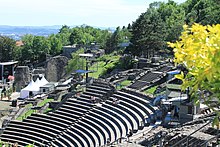
The Romans recognised that Lugdunum's strategic location at the convergence of two navigable rivers made it a natural communications hub. The city became the starting point of main Roman roads in the area, and it quickly became the capital of the province, Gallia Lugdunensis. Two Emperors were born in this city: Claudius, whose speech is preserved in the Lyon Tablet in which he justifies the nomination of Gallic Senators, and Caracalla.
Early Christians in Lyon were martyred for their beliefs under the reigns of various Roman emperors, most notably Marcus Aurelius and Septimius Severus.[27] Local saints from this period include Blandina, Pothinus, and Epipodius, among others. The Greek Irenaeus was the second bishop of Lyon during the latter part of the second century.[28] To this day, the archbishop of Lyon is still referred to as "Primat des Gaules".[29]
Burgundians fleeing the destruction of Worms by the Huns in 437 were re-settled in eastern Gaul. In 443 the Romans established the Kingdom of the Burgundians, and Lugdunum became its capital in 461. In 843, under the Treaty of Verdun, Lyon went to the Holy Roman Emperor Lothair I. It later was made part of the Kingdom of Arles which was incorporated into the Holy Roman Empire in 1033. Lyon did not come under French control until the 14th century.
Fernand Braudel remarked, "Historians of Lyon are not sufficiently aware of the bi-polarity between Paris and Lyon, which is a constant structure in French development...from the late Middle Ages to the Industrial Revolution".[30] In the late 15th century, the fairs introduced by Italian merchants made Lyon the economic counting house of France. Even the Bourse (treasury), built in 1749, resembled a public bazaar where accounts were settled in the open air. When international banking moved to Genoa, then Amsterdam, Lyon remained the banking centre of France.
During the Renaissance, the city's development was driven by the silk trade, which strengthened its ties to Italy. Italian influence on Lyon's architecture is still visible among historic buildings.[31] In the late 1400s and 1500s Lyon was also a key centre of literary activity and book publishing, both of French writers (such as Maurice Scève, Antoine Heroet, and Louise Labé) and of Italians in exile (such as Luigi Alamanni and Gian Giorgio Trissino).


In 1572, Lyon was a scene of mass violence by Catholics against Protestant Huguenots in the St. Bartholomew's Day Massacre. Two centuries later, Lyon was again convulsed by violence during the French Revolution, when the citizenry rose up against the National Convention and supported the Girondins. The city was besieged by Revolutionary armies for over two months before it surrendered in October 1793. Many buildings were destroyed, especially around the Place Bellecour, and Jean-Marie Collot d'Herbois and Joseph Fouché administered the execution of more than 2,000 people. The Convention ordered that its name be changed to "Liberated City", and a plaque was erected that proclaimed "Lyons made war on Liberty; Lyons no longer exists". A decade later, Napoleon ordered the reconstruction of all the buildings demolished during that period.
The convention was not the only target within Lyon during the French Revolution. After the Convention faded into history, the French Directory appeared and days after the 4 September 1797 Coup of 18 Fructidor, a Directory's commissioner was assassinated in Lyon.
The city became an important industrial town in the 19th century. In 1831 and 1834, the canuts (silk workers) of Lyon staged two major uprisings for better working conditions and pay. In 1862, the first of Lyon's extensive networkoffunicular railways began operation.
During World War II, Lyon was a centre for the occupying Nazi forces, including Klaus Barbie, the infamous "Butcher of Lyon". However, the city was also a stronghold of the French Resistance, the many secret passages known as traboules, enabled people to escape Gestapo raids. On 3 September 1944, Lyon was liberated by the 1st Free French Division and the Forces Françaises de l'Intérieur. The city is now home to a Resistance museum.[32][33]

The Rhône and Saône converge to the south of the historic city centre, forming a peninsula – the "Presqu'île" – bounded by two large hills to the west and north and a large plain eastward. Place Bellecour is located on the Presqu'île between the two rivers and is the third-largest public square in France. The broad, pedestrian-only Rue de la République leads north from Place Bellecour.
The northern hill is La Croix-Rousse, known as "the hill that works" because it is traditionally home to many small silk workshops, an industry for which the city has long been renowned.[34]
The western hill is Fourvière, known as "the hill that prays" because it is the location for Basilica of Notre-Dame de Fourvière, several convents, and Archbishop residence. The district, Vieux Lyon, also hosts the Tour métallique (a highly visible TV tower, replicating the last stage of the Eiffel Tower) and one of the city's railways.[35] Fourvière, along with portions of the Presqu'île and much of La Croix-Rousse, is designated as a UNESCO World Heritage Site.[36]
East of the Rhône from the Presqu'île is a large flat area upon which sits much of modern Lyon and contains most of the city's population. Situated in this area is La Part-Dieu urban centre, which clusters the landmark structures Tour Incity, Tour Part-Dieu, Tour Oxygène, and Tour Swiss Life, as well as the city's primary railway station, Gare de Lyon-Part-Dieu.
North of this district lays the sixth arrondissement, which is home to one of Europe's largest urban parks, the Parc de la Tête d'or, as well as Lycée du Parc and Interpol's world headquarters.
Lyon has a humid subtropical climate (Köppen: Cfa), bordering an oceanic climate (Köppen: Cfb, Trewartha: Do).[37] The mean temperature in Lyon in the coldest month is 4.1 °C (39.4 °F) in January and in the warmest month in July is 22.6 °C (72.7 °F). Precipitation is adequate year-round, at an average of 820 mm (32.3 in), the winter months are the driest. The highest recorded temperature was 40.5 °C (104.9 °F) on 13 August 2003 while the lowest recorded temperature was −24.6 °C (−12.3 °F) on 22 December 1938.[38]
| Climate data for Lyon (LYN), elevation: 197 m (646 ft), 1991–2020 normals, extremes 1920–present | |||||||||||||
|---|---|---|---|---|---|---|---|---|---|---|---|---|---|
| Month | Jan | Feb | Mar | Apr | May | Jun | Jul | Aug | Sep | Oct | Nov | Dec | Year |
| Record high °C (°F) | 19.1 (66.4) |
21.9 (71.4) |
26.0 (78.8) |
30.1 (86.2) |
34.2 (93.6) |
38.4 (101.1) |
40.4 (104.7) |
41.4 (106.5) |
35.8 (96.4) |
28.4 (83.1) |
23.0 (73.4) |
20.2 (68.4) |
41.4 (106.5) |
| Mean daily maximum °C (°F) | 7.1 (44.8) |
9.0 (48.2) |
13.8 (56.8) |
17.4 (63.3) |
21.5 (70.7) |
25.6 (78.1) |
28.2 (82.8) |
28.0 (82.4) |
23.1 (73.6) |
17.7 (63.9) |
11.4 (52.5) |
7.7 (45.9) |
17.5 (63.5) |
| Daily mean °C (°F) | 4.1 (39.4) |
5.2 (41.4) |
9.0 (48.2) |
12.3 (54.1) |
16.3 (61.3) |
20.3 (68.5) |
22.6 (72.7) |
22.3 (72.1) |
17.9 (64.2) |
13.7 (56.7) |
8.1 (46.6) |
4.8 (40.6) |
13.0 (55.4) |
| Mean daily minimum °C (°F) | 1.1 (34.0) |
1.4 (34.5) |
4.2 (39.6) |
7.2 (45.0) |
11.2 (52.2) |
15.0 (59.0) |
17.0 (62.6) |
16.6 (61.9) |
12.8 (55.0) |
9.6 (49.3) |
4.9 (40.8) |
2.0 (35.6) |
8.6 (47.5) |
| Record low °C (°F) | −23.0 (−9.4) |
−22.5 (−8.5) |
−10.5 (13.1) |
−4.4 (24.1) |
−3.8 (25.2) |
2.3 (36.1) |
6.1 (43.0) |
4.6 (40.3) |
0.2 (32.4) |
−4.5 (23.9) |
−9.4 (15.1) |
−24.6 (−12.3) |
−24.6 (−12.3) |
| Average precipitation mm (inches) | 49.8 (1.96) |
41.6 (1.64) |
49.4 (1.94) |
68.9 (2.71) |
80.9 (3.19) |
74.1 (2.92) |
67.4 (2.65) |
65.5 (2.58) |
82.5 (3.25) |
99.8 (3.93) |
87.2 (3.43) |
53.7 (2.11) |
820.8 (32.31) |
| Average precipitation days (≥ 1.0 mm) | 8.1 | 7.9 | 8.4 | 9.0 | 10.3 | 8.5 | 7.5 | 7.2 | 7.3 | 9.9 | 9.4 | 9.2 | 102.8 |
| Mean monthly sunshine hours | 71.1 | 102.4 | 173.7 | 197.7 | 223.8 | 256.5 | 288.1 | 263.1 | 204.1 | 131.4 | 78.9 | 58.7 | 2,049.5 |
| Source 1: Meteo France[39] | |||||||||||||
| Source 2: Meteo Lyon[40] | |||||||||||||
| Climate data for Lyon (LYN), elevation: 201 m, 1961-1990 normals and extremes | |||||||||||||
|---|---|---|---|---|---|---|---|---|---|---|---|---|---|
| Month | Jan | Feb | Mar | Apr | May | Jun | Jul | Aug | Sep | Oct | Nov | Dec | Year |
| Record high °C (°F) | 16.3 (61.3) |
21.4 (70.5) |
25.7 (78.3) |
28.0 (82.4) |
29.4 (84.9) |
34.4 (93.9) |
39.8 (103.6) |
37.1 (98.8) |
33.8 (92.8) |
28.4 (83.1) |
22.6 (72.7) |
20.2 (68.4) |
39.8 (103.6) |
| Mean maximum °C (°F) | 10.2 (50.4) |
14.4 (57.9) |
15.9 (60.6) |
18.6 (65.5) |
23.1 (73.6) |
28.8 (83.8) |
32.8 (91.0) |
28.1 (82.6) |
27.3 (81.1) |
19.7 (67.5) |
14.1 (57.4) |
9.5 (49.1) |
32.8 (91.0) |
| Mean daily maximum °C (°F) | 6.1 (43.0) |
8.2 (46.8) |
11.6 (52.9) |
15.2 (59.4) |
19.1 (66.4) |
22.9 (73.2) |
26.1 (79.0) |
26.0 (78.8) |
22.4 (72.3) |
17.1 (62.8) |
10.0 (50.0) |
6.4 (43.5) |
15.9 (60.7) |
| Daily mean °C (°F) | 3.0 (37.4) |
4.9 (40.8) |
7.4 (45.3) |
10.2 (50.4) |
14.0 (57.2) |
17.6 (63.7) |
20.6 (69.1) |
20.0 (68.0) |
17.1 (62.8) |
12.7 (54.9) |
6.7 (44.1) |
3.9 (39.0) |
11.5 (52.7) |
| Mean daily minimum °C (°F) | 0.2 (32.4) |
1.4 (34.5) |
2.9 (37.2) |
5.2 (41.4) |
9.1 (48.4) |
12.5 (54.5) |
14.8 (58.6) |
14.4 (57.9) |
11.7 (53.1) |
8.3 (46.9) |
3.5 (38.3) |
0.7 (33.3) |
7.1 (44.7) |
| Mean minimum °C (°F) | −7.0 (19.4) |
−4.7 (23.5) |
−1.4 (29.5) |
3.2 (37.8) |
7.6 (45.7) |
10.9 (51.6) |
13.1 (55.6) |
12.9 (55.2) |
8.1 (46.6) |
4.5 (40.1) |
1.0 (33.8) |
−4.7 (23.5) |
−7.0 (19.4) |
| Record low °C (°F) | −23.0 (−9.4) |
−19.3 (−2.7) |
−10.5 (13.1) |
−3.2 (26.2) |
−0.3 (31.5) |
3.6 (38.5) |
6.1 (43.0) |
5.2 (41.4) |
1.9 (35.4) |
−3.2 (26.2) |
−7.1 (19.2) |
−16.0 (3.2) |
−23.0 (−9.4) |
| Average precipitation mm (inches) | 54.0 (2.13) |
53.8 (2.12) |
72.2 (2.84) |
56.1 (2.21) |
72.6 (2.86) |
73.2 (2.88) |
54.5 (2.15) |
71.6 (2.82) |
53.2 (2.09) |
56.2 (2.21) |
68.0 (2.68) |
55.8 (2.20) |
741.2 (29.19) |
| Average precipitation days (≥ 1.0 mm) | 10.4 | 9.3 | 9.7 | 9.6 | 10.9 | 8.2 | 6.8 | 8.2 | 7.3 | 8.5 | 8.9 | 9.8 | 107.6 |
| Average snowy days | 5.5 | 3.9 | 2.5 | 1.1 | 0.0 | 0.0 | 0.0 | 0.0 | 0.0 | 0.0 | 2.0 | 4.6 | 19.6 |
| Average relative humidity (%) | 84 | 80 | 74 | 71 | 72 | 70 | 65 | 70 | 76 | 82 | 84 | 86 | 76 |
| Mean monthly sunshine hours | 62.6 | 89.8 | 147.5 | 184.2 | 215.9 | 250.9 | 292.6 | 259.0 | 208.1 | 134.3 | 75.3 | 55.4 | 1,975.6 |
| Percent possible sunshine | 23 | 31 | 41 | 46 | 47 | 54 | 62 | 60 | 56 | 40 | 27 | 21 | 42 |
| Source 1: NOAA[41] | |||||||||||||
| Source 2: Infoclimat.fr (humidity)[42] | |||||||||||||
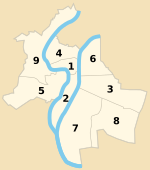
Like Paris and Marseille, the commune (municipality) of Lyon is divided into a number of municipal arrondissements, each of which is identified by a number and has its own council and town hall. Five arrondissements were originally created in 1852, when three neighbouring communes (La Croix-Rousse, La Guillotière, and Vaise) were annexed by Lyon. Between 1867 and 1959, the third arrondissement (which originally covered the whole of the Left Bank of the Rhône) was split three times, creating a new arrondissement in each case. Then, in 1963, the commune of Saint-Rambert-l'Île-Barbe was annexed to Lyon's fifth arrondissement. A year later, in 1964, the fifth was split to create Lyon's 9th – and, to date, final – arrondissement. Within each arrondissement, the recognisable quartiers or neighbourhoods are:
Geographically, Lyon's two main rivers, the Saône and the Rhône, divide the arrondissements into three groups:
This is a list of mayors of the commune of Lyon since the end of the 19th century.
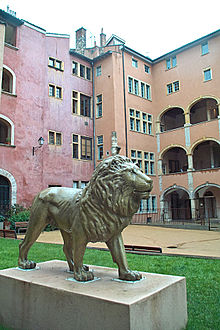
| Mayor | Term start | Term end | Party | |
|---|---|---|---|---|
| Antoine Gailleton | 1881 | 1900 | ||
| Victor Augagneur | 1900 | 30 October 1905 | PRS | |
| Édouard Herriot | 30 October 1905 | 20 September 1940 | Radical | |
| Georges Cohendy | 20 September 1940 | 1941 | Nominated and dismissed by Vichy | |
| Georges Villiers | 1941 | 1942 | Nominated and dismissed by Vichy | |
| Pierre-Louis-André Bertrand | 1942 | 1944 | Nominated by Vichy | |
| Justin Godart | 1944 | 18 May 1945 | Radical | |
| Édouard Herriot | 18 May 1945 | 26 March 1957 | Radical | |
| Pierre Montel, ad interim | 26 March 1957 | 14 April 1957 | Radical | |
| Louis Pradel | 14 April 1957 | 27 November 1976 | DVD | |
| Armand Tapernoux, ad interim | 27 November 1976 | 5 December 1976 | DVD | |
| Francisque Collomb | 5 December 1976 | 24 March 1989 | DVD | |
| Michel Noir | 24 March 1989 | 25 June 1995 | RPR | |
| Raymond Barre | 25 June 1995 | 25 March 2001 | DVD | |
| Gérard Collomb | 25 March 2001 | 17 July 2017 | PS | |
| Georges Képénékian | 17 July 2017 | 5 November 2018 | LREM | |
| Gérard Collomb | 5 November 2018 | 4 July 2020 | LREM | |
| Grégory Doucet | 4 July 2020 | Incumbent | EELV |

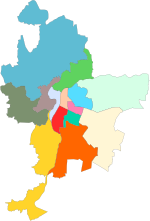
Since 2015, the commune of Lyon (48 km2 (19 sq mi) in land area) and 58 suburban communes have formed the Metropolis of Lyon (534 km2 (206 sq mi) in land area), a directly elected metropolitan authority now in charge of most urban issues. The Metropolis of Lyon is the only metropolitan authority in France which is a territorial collectivity, on par with French communes and departments. Its metropolitan council was for the first time directly elected by universal suffrage in 2020 within 14 electoral wards, the only directly elected metropolitan council in France.
The 14 electoral wards are the following (see map for location):
The six wards with names starting with "Lyon" are all located within the commune of Lyon. The Villeurbanne ward is coterminous with the namesake commune. All other seven wards each group various suburban communes.
The division of the Metropolis of Lyon in large electoral wards often grouping various communes and dividing the commune of Lyon into six wards was criticized by the suburban mayors, as it ended the rule of 'one commune, one metropolitan councilor'. The goal of this electoral division of the metropolis was to focus metropolitan elections more on metropolitan issues than parochial communal issues, and ensure the 'one person, one vote' rule be respected, by creating electoral wards of more homogeneous population sizes. Opponents said it diluted the voice of the small suburban communes, which are now part of large electoral wards and do not each possess a representative in the metropolitan council anymore.
The two first presidents of the Metropolis of Lyon's metropolitan council were chosen by indirectly elected metropolitan councilors. The current president since July 2020 was elected by new metropolitan councilors following their election by universal suffrage in March (1st round) and June (2nd round) 2020, the first direct election of a metropolitan council in France.
| President of the Metropolitan Council | Term start | Term end | Party | |
|---|---|---|---|---|
| Gérard Collomb | 1 January 2015 | 10 July 2017 | PS | |
| David Kimelfeld | 10 July 2017 | 2 July 2020 | LREM | |
| Bruno Bernard | 2 July 2020 | Incumbent | EELV |

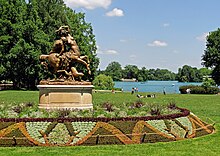

The GDP of Lyon was 124 billion US dollars in 2019,[f][45] making it the second richest city in France after Paris. Lyon and its region Rhône-Alpes represent one of the most important economies in Europe and, according to Loughborough University, can be compared to Philadelphia, Mumbai or Athens with regard to its international position. The city of Lyon is working in partnership to more easily enable the establishment of new headquarters in the territory (ADERLY, Chambre du commerce et d'industrie, Grand Lyon...). High-tech industries such as biotechnology, software development, video game (Arkane Studios, Ivory Tower, Eden Games, EA France, Bandai Namco Entertainment Europe), and internet services are also growing. Other important sectors include medical research and technology, non-profit institutions, and universities. Lyon is home to the P4-Inserm–ean Merieux Laboratory which conducts top-level vaccine research.[46]
The city is home to the headquarters of many large companies such as Groupe SEB, Sanofi Pasteur, Renault Trucks, Norbert Dentressangle, LCL S.A., Descours & Cabaud, Merial, Point S, BioMérieux, Iveco Bus, Compagnie Nationale du Rhône, GL Events, April Group, Boiron, Feu Vert, Panzani, Babolat, Lyon Airports, LVL Medical, and inter-governmental agencies IARC and Interpol. The specialisation of some sectors of activities has led to the creation of many main business centres: La Part-Dieu, located in the 3rd arrondissement is the second biggest business quarter after La Défense in Paris with over 1,600,000 m2 (17,222,256.67 sq ft) of office space and services and more than 55,000 jobs.[47] Cité Internationale, created by the architect Renzo Piano is located in the border of the Parc de la Tête d'Or in the 6th arrondissement. The worldwide headquarters of Interpol is located there. The district of Confluence, in the south of the historic centre, is a new pole of economical and cultural development.
Tourism is an important part of the Lyon economy, with one billion euros in 2007 and 3.5 million hotel-nights in 2006 provided by non-residents.[citation needed] Approximately 60% of tourists visit for business, with the rest for leisure.[citation needed] In January 2009, Lyon ranked first in France for hostels business.[citation needed] The festivals most important for attracting tourists are the Fête des lumières, the Nuits de Fourvière every summer, the Biennale d'art contemporain and the Nuits Sonores.
| UNESCO World Heritage Site | |
|---|---|

| |
| Criteria | Cultural: (ii)(iv) |
| Reference | 872 |
| Inscription | 1998 (22nd Session) |
| Area | 427 ha (1,060 acres) |
| Buffer zone | 323 ha (800 acres) |
Since the Middle Ages, the region residents have spoken several dialects of Franco-Provençal. The Lyonnais dialect was replaced by the French language as the importance of the city grew. However some "frenchified" Franco-Provençal words can also be heard in the French of the Lyonnais, who call their little boys and girls "gones" and "fenottes" for example.[48]

The historic site of Lyon was designated a UNESCO World Heritage Site in 1998. In its designation, UNESCO cited the "exceptional testimony to the continuity of urban settlement over more than two millennia on a site of great commercial and strategic significance."[36] The specific regions comprising the historic site include the Roman district and Fourvière, the Renaissance district (Vieux Lyon), the silk district (slopes of Croix-Rousse), and the Presqu'île, which features architecture from the 12th century to modern times.[52]
Both Vieux Lyon and the slopes of Croix-Rousse are known for their narrow passageways (named traboules) that pass through buildings and link streets on either side. The first examples of traboules are thought to have been built in Lyon in the 4th century.[53] The traboules allowed the inhabitants to get from their homes to the Saône quickly and allowed the canuts on the Croix-Rousse hill to get from their workshops to the textile merchants at the foot of the hill.

Lyon has a long and chronicled culinary arts tradition. The noted food critic Curnonsky referred to the city as "the gastronomic capital of the world",[54] a claim repeated by later writers such as Bill Buford.[55] Renowned 3-star Michelin chefs such as Marie Bourgeois[56] and Eugénie Brazier[57] developed Lyonnaise cuisine into a national phenomenon favoured by the French elite; a tradition which Paul Bocuse later turned into a worldwide success.[58]
The bouchon is a traditional Lyonnais restaurant that serves local fare such as sausages, duck pâté or roast pork, along with local wines. Two of France's best known wine-growing regions are located near the city: the Beaujolais region to the north and the Côtes du Rhône region to the south. Another Lyon tradition is a type of brunch food called "mâchons", made of local charcuterie and usually accompanied by Beaujolais red wine. Mâchons were the customary meal of the canuts, the city's silk workers, who ate a late-morning meal after they finished their shifts in the factories.[59]
Other traditional local dishes include coq au vin; quenelle; gras double; salade lyonnaise (lettuce with bacon, croûtons and a poached egg); and the sausage-based rosette lyonnaise and andouillette. Popular local confections include marron glacé and coussin de Lyon. Cervelle de canut (literally, "silk worker's brains") is a cheese spread/dip made of a base of fromage blanc, seasoned with chopped herbs, shallots, salt, pepper, olive oil and vinegar.
More recently, the french tacos was invented in Lyon suburbs (Vaulx-en-Velin) (orGrenoble according to some theories), in the early 2000s and is now famous worldwide.[60]'[61]
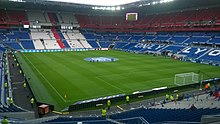
Lyon is home to the football club Olympique Lyonnais (OL), whose men's team plays in Ligue 1 and has won the championship of that competition seven times, all consecutively from 2002 to 2008.[62] OL played until December 2015 at the 43,000-seat Stade de Gerland, which also hosted matches of the 1998 FIFA World Cup. Since 2016, the team has played at the Parc Olympique Lyonnais, a 59,000-seat stadium located in the eastern suburb of Décines-Charpieu.[63] OL operates a women's team, Olympique Lyonnais Féminin, which competes in and dominates Division 1 Féminine. They won fourteen consecutive top-flight championships (2007–2020), and additionally claim the four titles won by the original incarnation of FC Lyon, a women's football club that merged into OL in 2004 (the current FC Lyon was founded in 2009). The OL women have also won the UEFA Women's Champions League eight times, including in five consecutive editions from 2016 to 2020. Lyon hosted the 2019 FIFA Women's World Cup semi-finals as well as the Final on 7 July at Stade de Lyon.
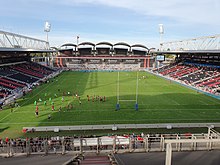
Lyon has a rugby union team, Lyon OU, in the Top 14, which moved into Stade de Gerland full-time in 2017–18. In addition, Lyon has a rugby league side called Lyon Villeurbanne that plays in the French rugby league championship. The club's home is the Stade Georges Lyvet in Villeurbanne.
Lyon is also home to the Lyon Hockey Club, an ice hockey team that competes in France's national ice hockey league. The Patinoire Charlemagne is the seat of Club des Sports de Glace de Lyon, the club of Olympic ice dancing champions Marina Anissina and Gwendal Peizerat, and world champions Isabelle Delobel and Olivier Shoenfelder.[64] Lyon-Villeurbanne also has a basketball team, ASVEL, that plays at the Astroballe arena.
Since 2000, Birdy Kids, a group of graffiti artists from the city, has decorated several random buildings and walls along the Lyon ring road. In 2012, the artist collective was chosen to represent the city as its cultural ambassadors.[65]
The population of the city (commune) of Lyon proper was 522,969 at the January 2019 census.[14] As of 2011, 14% of its population was born outside Metropolitan France.[66]
|
|
| ||||||||||||||||||||||||||||||||||||||||||||||||||||||||||||||||||||||||||||||||||||||||||||||||||||||||||||||||||||||||
| ||||||||||||||||||||||||||||||||||||||||||||||||||||||||||||||||||||||||||||||||||||||||||||||||||||||||||||||||||||||||||
| All figures come from population censuses. Figures from 1911 to 1936 (incl.) are the redressed figures calculated by INSEE to correct the overestimated population of Lyon published by the municipal authorities at the time (10,000s of false residents had been added by the municipal authorities to artificially inflate the population figures and remain the 2nd largest city of France ahead of Marseille).[67] The 1906 figure is the one published by the municipal authorities, probably already inflated, but not corrected by INSEE because the overestimate was smaller than 10,000. Source: EHESS[68] and INSEE[14] | ||||||||||||||||||||||||||||||||||||||||||||||||||||||||||||||||||||||||||||||||||||||||||||||||||||||||||||||||||||||||||
| Country of birth | Population (2020) |
|---|---|
| 14,779 | |
| 5,245 | |
| 4,879 | |
| 3,351 | |
| 3,068 | |
| 2,064 | |
| 1,520 | |
| 1,429 | |
| 1,364 | |
| 1,198 |
The city of Lyon and 58 suburban municipalities have formed since 2015 the Metropolis of Lyon, a directly elected metropolitan authority now in charge of most urban issues, with a population of 1,411,571 in 2019.[15]
|
|
| |||||||||||||||||||||||||||||||||||||||||||||||||||||||||||||||||||||||||||||||||||||||
| |||||||||||||||||||||||||||||||||||||||||||||||||||||||||||||||||||||||||||||||||||||||||
| All figures come from population censuses. Figures from 1911 to 1936 (incl.) are computed using the redressed figures for the commune of Lyon calculated by INSEE to correct the overestimated population of Lyon published by the municipal authorities at the time (10,000s of false residents had been added by the municipal authorities to artificially inflate the population figures and remain the 2nd largest city of France ahead of Marseille).[67] The 1906 figure is computed using the figure for the commune of Lyon published by the municipal authorities, probably already inflated, but not corrected by INSEE because the overestimate was smaller than 10,000. Source: EHESS[70] and INSEE[71] | |||||||||||||||||||||||||||||||||||||||||||||||||||||||||||||||||||||||||||||||||||||||||


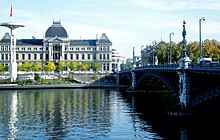
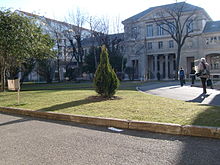

There are some international private schools in the Lyon area, including:
Other Japanese supplementary schools:
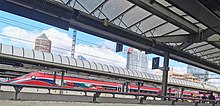




Lyon–Saint-Exupéry Airport, located east of Lyon, serves as a base for domestic and international flights. It is a key transport facility for the entire Rhône-Alpes region, with coach links to other cities in the area. The in-house train station Gare de Lyon Saint-Exupéry connects the airport to the nationwide TGV network. The Rhônexpress tram monopoly links the airport with the business quarter of La Part Dieu in less than 30 minutes, and offers connections with Underground A & B, Tramway T1, T3 & T4, and bus lines. Lyon public transport Sytral offers a bus service, Route 47, that links the airport to Meyzieu[74] where passengers can change onto Tram T3. The regular price of public transport is €1.90, as opposed to €15 one way for the Rhonexpress. In the suburb of Bron, the smaller Lyon-Bron Airport provides an alternative for domestic aviation.
Lyon has two major railway stations: Lyon-Part-Dieu, which was built to accommodate the TGV, and Lyon Perrache, an older station that now provides mostly regional service. Smaller railway stations include Gorge-de-Loup, Vaise, Saint-Paul and Jean Macé. Lyon was the first city to be connected to Paris by the TGV in 1981.[75] Since that time the TGV train network has expanded and links Lyon directly to Perpignan, Toulouse, Nice, Marseille, Strasbourg, Nantes and Lille. International trains operate directly to Madrid, Barcelona, Milan, Turin, Geneva, Frankfurt, Luxembourg, Brussels and London.
The city is at the heart of a dense road network and is located at the meeting point of several highways: A6 to Paris, A7 Marseille, A42toGeneva, and A43toGrenoble. The city is now bypassed by the A46. A double motorway tunnel passes under Fourvière, connecting the A6 and the A7 autoroutes, both forming the "Autoroute du Soleil".
Lyon is served by the Eurolines intercity coach organisation. Its Lyon terminal is located at the city's Perrache railway station, which serves as an intermodal transportation hub for tramways, local and regional trains and buses, the terminus of Metro line A, of the Tramway T2, the bicycle service Vélo'v, and taxis.[76]
The Transports en commun lyonnais (TCL), Lyon's public transit system, consisting of metro, tramways and buses, serves 62 communes of the Lyon metropolis.[77][78] The metro network has four lines (A, B, C and D), 42 stations, and runs with a frequency of up to a train every 2 minutes. There are eight Lyon tram lines since november 2020: T1 from Debourg in the south to IUT-Feyssine in the north, Tram T2 from Hôtel de région MontrochettoSaint-Priest in the south-east, Tram T3 from Part-Dieu to Meyzieu, Tram T4 from 'Hôptial Feyzin Venissieux' to La Doua Gaston Berger. Tram T5 from Grange Blanche, in the south-east to Eurexpo in the south-west. Tram T6 from Debourg, in the south to Hôpitaux Est-Pinel in the east. Tram T7 from Vaux-en-Velin la soie, in the north-east to Décines – OL Vallée in the east.[78] And Rhône Express tramline from Part-Dieu to Lyon–Saint-Exupéry Airport.[79][80] The Lyon bus network consists of the Lyon trolleybus system, motorbuses, and coaches for areas outside the centre. There are also two funicular lines from Vieux Lyon to Saint-Just and Fourvière. The ticketing system is relatively simple as the city has only one public transport operator, the SYTRAL.
The public transit system was complemented in 2005 by Vélo'v, a bicycle network providing a low-cost bicycle-hire service made up of 340 stations throughout the city. Borrowing a bicycle for less than 30 minutes is free. Free rental time can be extended for another 30 minutes at any station. Lyon was the first city in France to introduce this bicycle renting system. In 2011 the Auto'lib car rental service was introduced; it works much the same way as the Velo'v but for cars.
The average amount of time people spend commuting with public transit in Lyon on a weekday is 45 minutes. The average amount of time people wait at a stop or station for public transit is 11 min, while 17% of riders wait for over 20 minutes on average every day. The average distance people usually ride in a single trip with public transit is 4.7 km, while 4% travel for over 12 km in a single direction.[81]
Lyon is a pilot city of the Council of Europe and the European Commission "Intercultural cities" program.[82] Lyon is twinned with:[83]
Lugduno – desiderato monte: dunum enim montem Lugduno: "mountain of yearning"; dunum of course is mountain.www.maryjones.us/ctexts/endlicher_glossary.html
|
| |
|---|---|
| Metropolitan regions |
|
| Overseas regions |
|
|
Cities in France by population
| |
|---|---|
| 2,000,000+ |
|
| 500,000+ |
|
| 200,000+ |
|
| 100,000+ |
|
| |
|
| ||
|---|---|---|
| Île-de-France |
| |
| Parisian basin |
| |
| Nord-Pas-de-Calais |
| |
| East |
| |
| West |
| |
| South West |
| |
| Centre East |
| |
| Mediterranean |
| |
| Multiple regions |
| |
| Overseas departments and territories |
| |
| ||
| International |
|
|---|---|
| National |
|
| Geographic |
|
| Other |
|